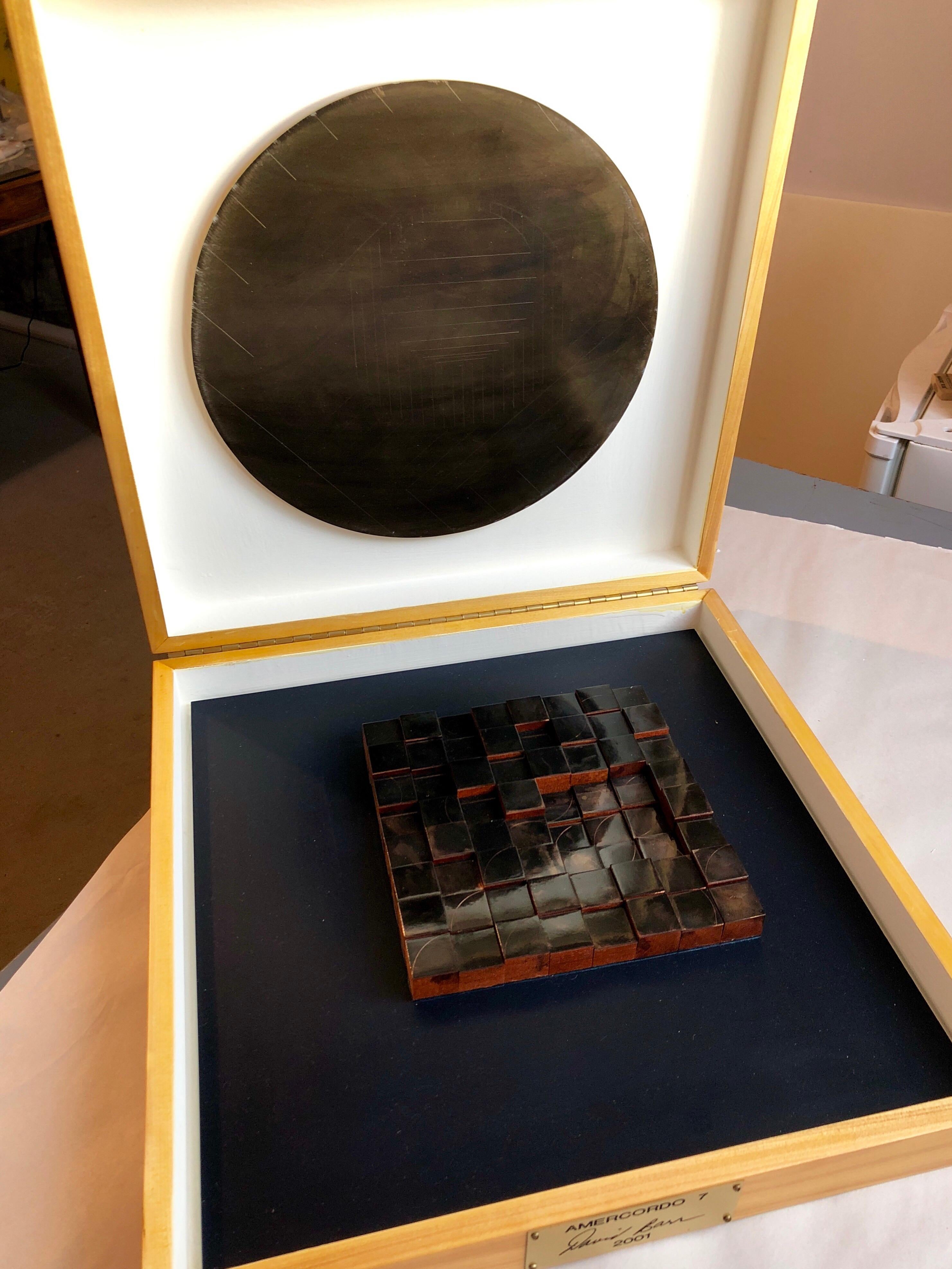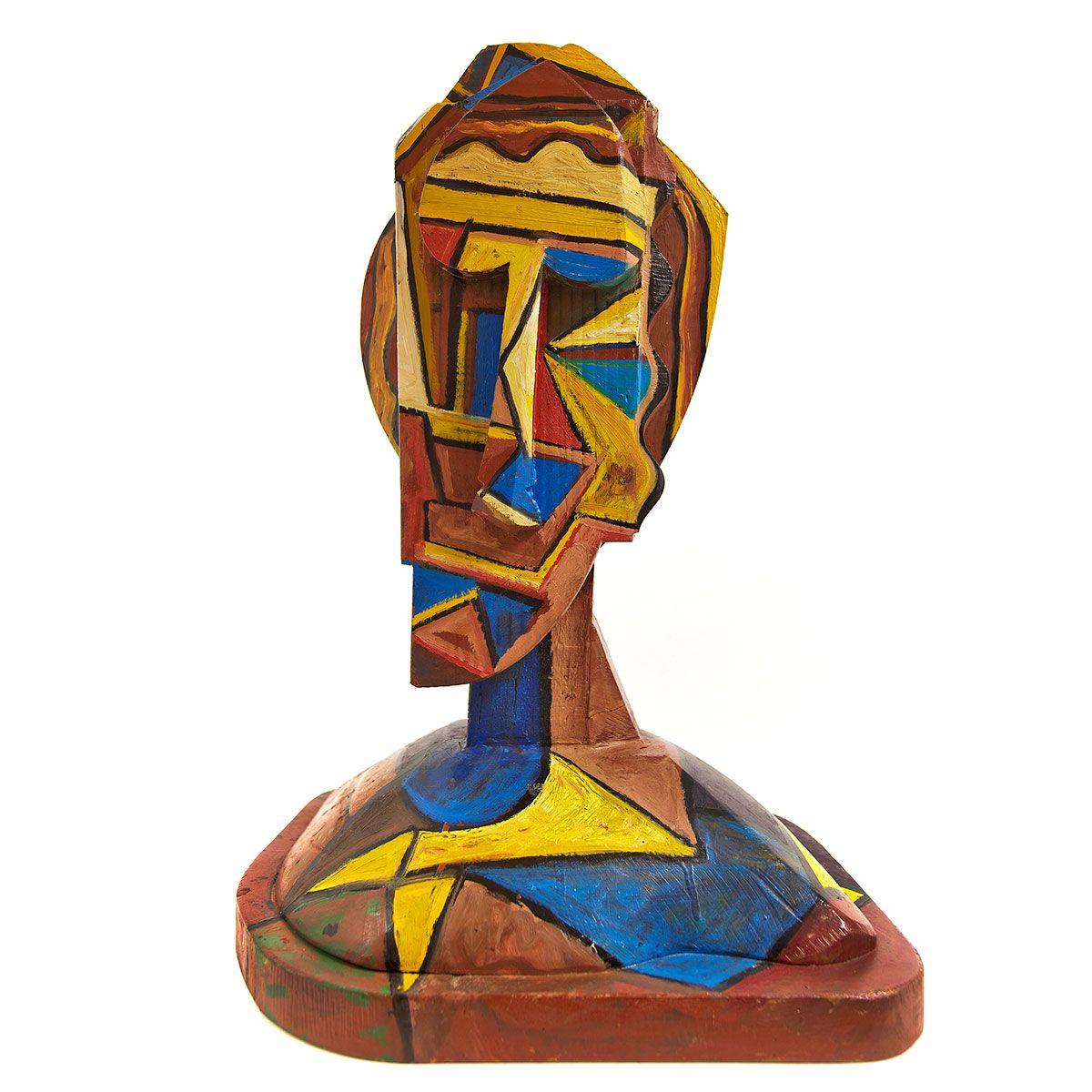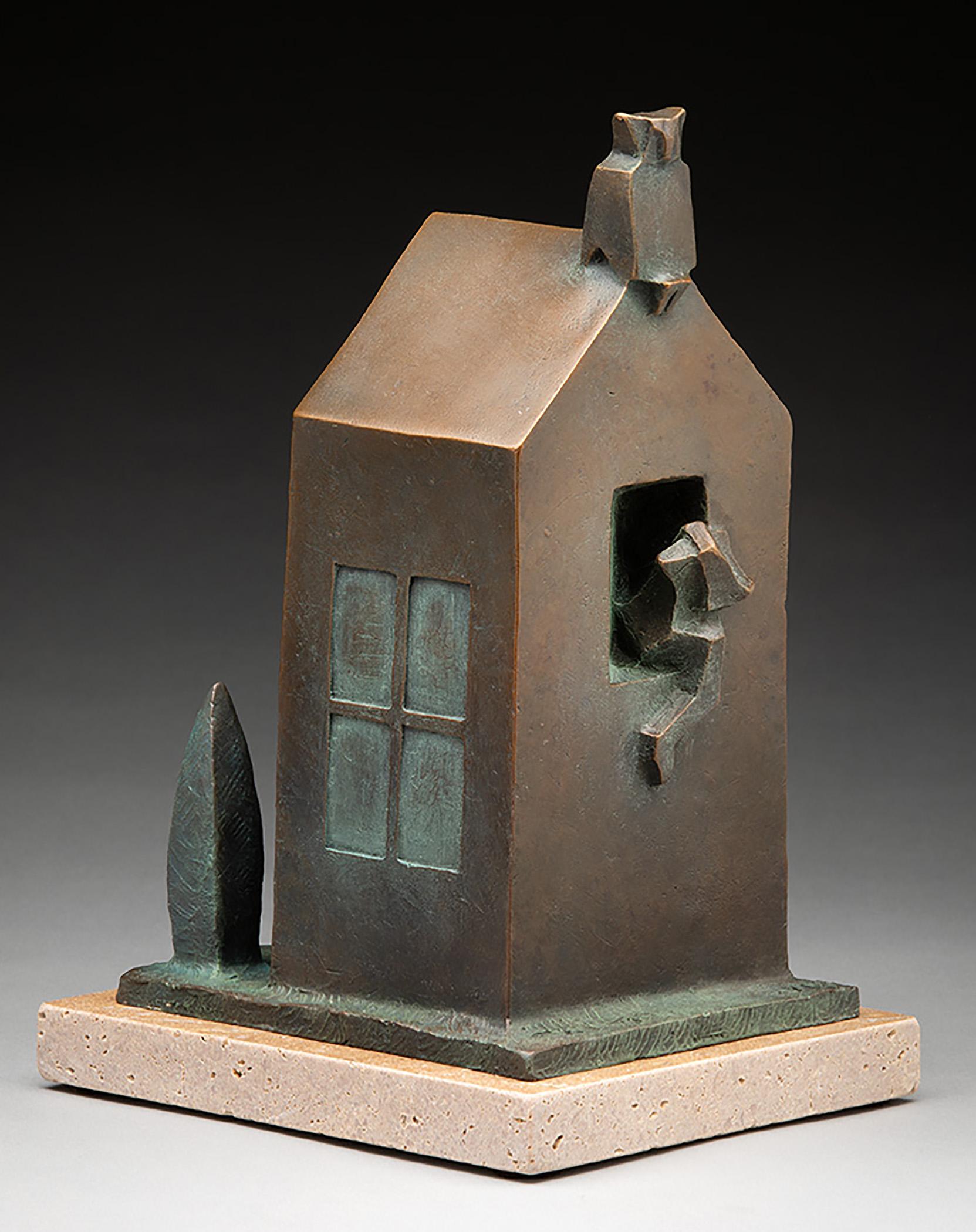Items Similar to Cello
Want more images or videos?
Request additional images or videos from the seller
1 of 2
Koji TakeiCello2020
2020
About the Item
Koji Takei works reference synthetic cubism in the most literal of senses. In cubist artworks, the objects are broken up, analyzed and re-assembled in abstracted form. These pieces, sculpted meticulously from objects of our everyday life, allude to the deconstructed instruments that often were referenced by Picasso and Braque in their first phase of explorations into cubism.
As much as Takei’s pieces are Cubist in nature there is also an unmistakable Asian influence in the working method of the Japanese native. A quiet solidarity and respect for the individual parts set the pieces apart from the noisy commentary that Cubism often invokes. Takei’s pieces are minimal in nature, but powerful in presence and seem to reference the interlocking sculptures by fellow Japanese-American, the late Isamu Noguchi.
Koji Takei is a sculptor living and working in Los Angeles, California. He has taught at the California Institute of the Arts in Valencia, CA, Otis College of Art and Design in Los Angeles, and is currently a faculty member at the Art Center College of Design in Pasadena and Academy of Art University in San Francisco. His art has been the subject of recent exhibitions at Laguna Art Museum in Laguna Beach and the Japanese American National Museum in Los Angeles.
- Creator:Koji Takei (1955, Japanese)
- Creation Year:2020
- Dimensions:Height: 53 in (134.62 cm)Width: 14 in (35.56 cm)Depth: 7 in (17.78 cm)
- Medium:
- Movement & Style:
- Period:
- Condition:
- Gallery Location:Santa Monica, CA
- Reference Number:1stDibs: LU47813785712
About the Seller
5.0
Vetted Seller
These experienced sellers undergo a comprehensive evaluation by our team of in-house experts.
Established in 1991
1stDibs seller since 2014
10 sales on 1stDibs
Typical response time: 10 hours
- ShippingRetrieving quote...Ships From: Santa Monica, CA
- Return PolicyA return for this item may be initiated within 7 days of delivery.
More From This SellerView All
- UntitledBy Koji TakeiLocated in Santa Monica, CAKoji Takei works reference synthetic cubism in the most literal of senses. In cubist artworks, the objects are broken up, analyzed and re-assembled in abstracted form. These pieces...Category
2010s Contemporary Abstract Sculptures
MaterialsWood, Varnish
- Untitled (Bouquet)By Koji TakeiLocated in Santa Monica, CAKoji Takei works reference synthetic cubism in the most literal of senses. In cubist artworks, the objects are broken up, analyzed and re-assembled in abstracted form. These pieces...Category
2010s Abstract Abstract Sculptures
MaterialsMetal
- Composition 5By Koji TakeiLocated in Santa Monica, CAKoji Takei works reference synthetic cubism in the most literal of senses. In cubist artworks, the objects are broken up, analyzed and re-assembled in abstracted form. These pieces...Category
2010s Abstract Abstract Sculptures
MaterialsMetal
- Untitled TriptychBy Eric JohnsonLocated in Santa Monica, CAEric Johnson creates enigmatic and sensual abstract sculptures that are constructed with pigment, wood and resin. Johnson’s work seamlessly unites two traditions of Southern California art - the sleek and sexy aesthetic of the Finish Fetish movement and the organic and elegant tradition of woodworking. His handcrafted pieces are sheathed in resin skins, which often reveal glimpses of the wooden architectures encased within. Endlessly fascinated by physics and science, Johnson’s references range from cosmology and astrophysics to the human form. Johnson’s work is deeply personal - in addition to drawing inspiration from his ancestral boat-building heritage (which is Norwegian, Scottish and Cree Native...Category
1990s Abstract Abstract Sculptures
MaterialsEnamel
- UntitledBy Koji TakeiLocated in Santa Monica, CACreating sculptures of exquisite peculiarity is an art in which Takei excels. His elegantly crafted works embody the notion of the whimsical, contradictory and idiosyncratic. There is an immediately detectable sense of humor and quick wit about the sculptures in this exhibition. Beyond playfulness, however, Takei’s aim is to challenge the viewer to alter the way in which they look at reality. Taking cues from the Surrealists of the early 20th century, Takei transforms the mundane into the fantastic - and sometimes absurd. His work is a constant inquiry into the meaning of functionality and the perception of purpose. Much like Man Ray’s iconic readymade sculpture, The Gift (1921), and Meret Oppenheim’s infamous fur-covered teacup (Object, 1936), Takei recontextualizes those pragmatic objects that we immediately recognize. With his piece Soft Shoulders (2011), Takei deconstructs a wooden clothes hanger...Category
Early 2000s Abstract Abstract Sculptures
MaterialsEnamel, Metal
- Windsor IBy Koji TakeiLocated in Santa Monica, CAAs much as Takei’s pieces are Cubist in nature there is also an unmistakable Asian influence in the working method of the Japanese native. A quiet solidarity and respect for the individual parts set the pieces apart from the noisy commentary that Cubism often invokes. Takei’s pieces are minimal in nature, but powerful in presence and seem to reference the interlocking sculptures...Category
2010s Contemporary Abstract Sculptures
MaterialsMetal, Enamel
You May Also Like
- Modernist Detroit Table Sculpture Wood Collage Box Assemblage Americordo CopperLocated in Surfside, FLCopper and wood box. "Americordo #7" is composed of copper tiles inlaid to the bottom half of the box and on the top rests a patinated etched copper or bronze circle. The box when closed measures to be 17" Sq. x 3.5" H. David Barr (1939-2015) is an American sculptor and painter from Detroit, MI. Known for constructivist sculpture, architecture and surrealist, assemblage box sculpture collage works. Born in 1939, Barr is an internationally known artists and has created many installations in natural settings. Vault took over a year to complete. His sculptures represent mathematics, geography and structurist nature, and otherwise known as "geo-structures." This one is kinetic and can be moved around. Barr is a graduate of Wayne State University and recipient of the WSU Distinguished Alumni Award. Influenced by sculptor Charles Biederman. In 1995 he founded the Michigan Legacy Art Park, and has pieces at the Chrysler World Headquarters, Flint's Bishop Airport, the Detroit Zoo, the State of Michigan Historical Museum and the Meadowbrook Festival Grounds Barr earned a master’s of fine arts degree from Wayne State University and was an associate professor of sculpture at Macomb Community College in Warren for 37 years. He worked on perhaps the largest sculpture in the world, the Four Corners Project, with installations at Greenland, Africa, Irian Jaya (New Guinea) and Easter Island. His sculptures are located all over the state of Michigan, but perhaps his most recognizable is Transcending, a blend of bronze, steel and granite that acknowledges the contributions of Detroit’s laborers and skilled tradespeople. David Barr is the founder of Michigan Legacy Art Park. David’s career as an artist, instructor, author and global thinker has crossed borders around the world, bringing people and ideas together. Over fifty years as a sculptor, David created a body of work that includes hundreds of wall-hanging structurist reliefs, sculptures for public spaces (such as Transcending in Hart Plaza, Detroit done with Sergio De Giusti), works for private collections, massive global projects (such as The Four Corners Project) and Michigan Legacy Art Park. David’s studio was in Detroit for fifteen years until he realized he needed nature as a source of inspiration. In 1977 he bought 4 acres of land in rural Oakland County (now Novi) and in 1979 built his home, a contemporary structure that has become the centerpiece of his own art park. His work is included in the collection of outdoor sculptures at The Dennos Museum Center along with Clement Meadmore, Hanna Stiebel...Category
1990s Cubist Abstract Sculptures
MaterialsMetal, Copper
- Abstract Geometric Cubist Painted Wood Sculpture Head Italian Neo Figurative ArtBy Italo ScangaLocated in Surfside, FLThis painted wood assemblage sculpture by Italo Scanga, epitomizes the characteristics of his oeuvre. Polychrome head portrait bust. This was signed on a brass or bronze plaque but that has gone missing. It is unsigned. I believe there might be a studio stamp on the bottom. Italo Scanga (June 6, 1932 - July 7, 2001), an Italian-born American artist, was known for his sculptures, prints and, paintings, mostly created from found objects. In his youth in Calabria, Italy he worked as a cabinetmaker's apprentice and studies sculpture with a man who carved statues of saints. Italo Scanga was an innovative neo Dada, neo-Expressionist, and neo-Cubist multimedia artist who made assemblage, collage, sculptures of ordinary objects and created prints, glass, and ceramic works. Modern Italian abstract geometric folk art. Scanga's materials included natural objects like branches and seashells, as well as kitsch figurines, castoff musical instruments and decorative trinkets salvaged from flea markets and thrift shops. He combined these ingredients into free-standing assemblages, which he then painted. Although visually ebullient, the results sometimes referred to gruesome episodes from Greek mythology or the lives and deaths of martyred saints. He considered his artistic influences to be sweepingly pan-cultural, from African sculpture to Giorgio de Chirico. He often collaborated with the sculptor Dale Chihuly, who was a close friend. Constructed of wood and glass, found objects or fabric, his ensembles reflect a trio of activities—working, eating, and praying. These activities dominate the lives of those who live close to the land, but they are also activities that are idealized by many who contemplate, romantically, a simpler, bucolic life. Italo graduated from Michigan State University where he befriended fellow artists Richard Merkin and David Pease. He studied under Lindsey Decker who introduces him to welding and sculpture after his initial interest in photography. Also studies with Charles Pollock, the brother of Abstract Expressionist Jackson Pollock. His first teaching job was at University of Wisconsin (through 1964). where he met Harvey Littleton, a fellow instructor. He later moves to Providence, Rhode Island,I to teach at Rhode Island School of Design (RISD). Is colleagues with artists Richard Merkin and Hardu Keck. Starts a correspondence with HC Westermann. Spends summers teaching at Brown University; colleague of Hugh Townley. Moves to State College, PA, and teaches at Pennsylvania State University for one year. Meets artists Juris Ubans, Harry Anderson, Richard Frankel, and Richard Calabro, who remain friends throughout his career. 1967: David Pease helps him get a tenure track position at Tyler School of Art in Philadelphia, PA, . Artists he works closely with include Ernest Silva, Lee Jaffe, Donald Gill, and William Schwedler. Meets graduate student Dale Chihuly while lecturing at RISD and develops a lifelong friendship. 1969: One person exhibition, Baylor Art Gallery, Baylor University, Waco, TX. Works very closely with students Larry Becker and Heidi Nivling (who later run a gallery in Philadelphia, PA), and Harry Anderson. Welcomes many artists into his home including Donald Judd, Dan Flavin, Bruce Nauman (a former student), Vito Acconci, Ree Morton and Rafael Ferrer. 1973: "Saints Glass" at 112 Greene Street Gallery, NYC. Installation at the Institute of Contemporary Art at University of Pennsylvania, Philadelphia, PA. Meets Gordon Matta Clark and contributes to an artist cookbook. Goes to Pilchuck Glass School, Stanwood, WA, founded by Dale Chihuly, as a visiting artist. He continues to work there annually through 2001. Works over the years with Pilchuck artists Richard Royal, Seaver Leslie, Jamie Carpenter, Joey Kirkpatrick, Flora Mace, Robbie Miller, Billy Morris, Buster Simpson, Toots Zynsky, Howard Ben Tre...Category
1980s Cubist Abstract Sculptures
MaterialsWood, Oil
- 'Blue Tone Tower': Modernist Vibrant Blues Cubist Sculpture by Bill LowBy Bill LowLocated in Hudson, NYCubist style abstract mixed-media sculpture titled 'Blue Tone Tower' was created using various materials including wood, papier-mache, and paint by Bill Low ...Category
Mid-20th Century Cubist Abstract Sculptures
MaterialsWood, Paint, Paper
- Modernist Cubist Sculpture by Bill Low with Weathered Bronze FinishBy Bill LowLocated in Hudson, NYCubist abstract mixed-media sculpture titled 'Horse and Rider' was created using various materials including wood, papier-mache, and paint by Bill Low (Scotl...Category
Mid-20th Century Cubist Abstract Sculptures
MaterialsWood, Paint, Paper
- "Petit masque découpé Montserrat", 20th Century Bronze by Julio GonzálezLocated in Madrid, ESJULIO GONZÁLEZ Spanish, 1876 - 1942 PETIT MASQUE DÉCOUPÉ MONTSERRAT signed "GONZALEZ" 5 of an edition of 9 Cire Perdue "C. VALSUANI" foundry seal bronze...Category
1930s Cubist Abstract Sculptures
MaterialsBronze
- "Cabin Fever 2" Bronze cast mini sculpture of a house with owl, CubismBy Wayne SalgeLocated in Edgartown, MAThe historic tradition of cast bronze provides a contemporary avenue for the creation of Wayne Salge’s abstracted human and animal figures. Thoroughly modern and distinctly impressio...Category
2010s Cubist Abstract Sculptures
MaterialsBronze



